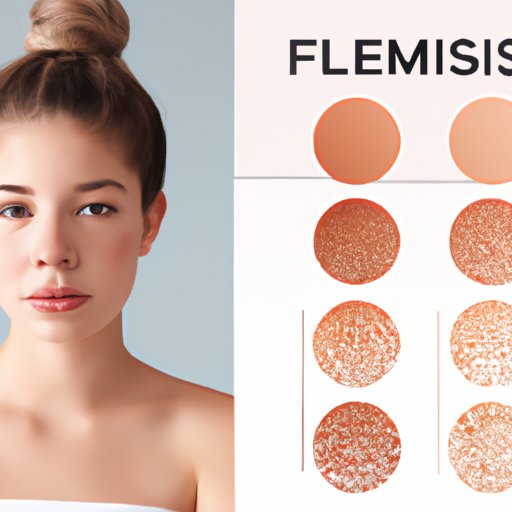
Introduction
Freckles, also known as ephelides, are small brown spots or patches that appear on the skin. They are caused by an increase in the production of melanin, the pigment that gives skin its color. Freckles are most commonly found on the face, neck, chest, and arms, and are often more visible during the summer months when sun exposure increases. In this article, we will explore the different factors that contribute to freckle formation and provide tips on skincare and sun protection.
The Genetics of Freckles: How Your DNA Influences Their Appearance
Freckles are largely determined by genetics. People with fair skin and red or blonde hair are more likely to have freckles than those with darker skin and hair. This is because fair-skinned individuals have less melanin in their skin, which makes them more susceptible to sun damage and freckling. Genes also play a role in the type of freckles that develop. Some individuals have distinct, uniform freckles, while others have more freckles that are less uniform in shape and distribution.
The production of melanin is also influenced by genetics. Melanin is produced by cells called melanocytes, which are located in the skin. These cells are activated by exposure to UV radiation from the sun. People with certain genetic variations may produce more melanin in response to sun exposure, which can lead to the development of freckles.
Sun Exposure and Freckles: The Science Behind UV Rays and Skin Pigmentation
Sun exposure is one of the primary triggers for freckle formation. When skin is exposed to UV radiation from the sun, it triggers the production of melanin. In people with fair skin, this can lead to the development of freckles. However, in individuals with darker skin, the production of melanin can cause the skin to darken, resulting in a tan.
Over time, repeated exposure to UV radiation can damage the skin and lead to premature aging, wrinkles, and even skin cancer. This is why it is important to protect your skin from the sun, especially during peak sun hours between 10 am and 4 pm.
It is also important to note that freckles are not the same as sunburns or tan lines. Sunburns occur when the skin is damaged by excessive UV radiation, while tan lines are a result of uneven exposure to the sun. Freckles, on the other hand, are caused by an increase in melanin production as a response to UV radiation.
Skincare Tips for Protecting Your Skin from Freckles and Sun Damage
The best way to prevent freckles is to protect your skin from the sun. This can be done through a combination of sunscreen, protective clothing, and avoiding mid-day sun exposure.
Sunscreen should be applied to all exposed skin at least 15 minutes before going outside and reapplied every two hours. Look for a broad-spectrum sunscreen with an SPF of at least 30, which will protect against both UVA and UVB radiation.
Protective clothing, such as long-sleeved shirts, pants, and wide-brimmed hats, can also help to shield your skin from the sun. Try to stay in shaded areas whenever possible, especially during peak sun hours.
Aside from sun protection, maintaining a healthy diet and staying hydrated can also help to keep your skin healthy. Eating foods rich in antioxidants, such as berries, leafy greens, and nuts, can help to protect your skin from damage. Drinking plenty of water can also help to keep your skin hydrated and prevent dryness and flakiness.
The Connection between Freckles and Hormones: Understanding Melanin Production
Hormones can also play a role in freckle formation. Melanin production is regulated by hormones such as estrogen, progesterone, and melanocyte-stimulating hormone (MSH). Changes in hormone levels during pregnancy, puberty, and menopause can all affect melanin production and lead to the development of freckles.
Pregnant women in particular are more susceptible to the development of freckles, as pregnancy hormones can increase melanin production. These freckles, known as melasma or the “mask of pregnancy,” are often temporary and may fade after pregnancy. However, they can sometimes persist for several years.
Debunking Common Myths about Freckles: Separating Fact from Fiction
There are many common misconceptions about freckles. One of the most pervasive myths is that freckles only occur in people with fair skin. While it is true that fair-skinned individuals are more susceptible to freckles, people with darker skin can also develop freckles. These freckles may be less visible, but they are still a sign of melanin production in response to UV radiation.
Another myth surrounding freckles is that they are a sign of skin damage or cancer. While it is true that sun damage can lead to skin cancer, freckles themselves are not harmful. They are simply a sign that your skin is producing more melanin in response to UV radiation.
Finally, it is important to distinguish between freckles and age spots. Age spots, also known as liver spots, are caused by years of sun exposure and tend to occur later in life. They are larger and darker than freckles and are often found on areas of the skin that receive the most sun exposure, such as the face and hands.
Conclusion
In conclusion, freckles are a common skin condition that are largely influenced by genetics and sun exposure. Protecting your skin from the sun is the best way to prevent freckles and reduce your risk of skin damage and cancer. This can be done through a combination of sunscreen, protective clothing, and avoiding mid-day sun exposure. By taking small steps to protect your skin, you can enjoy the summer sun without having to worry about freckles or other skin damage.





